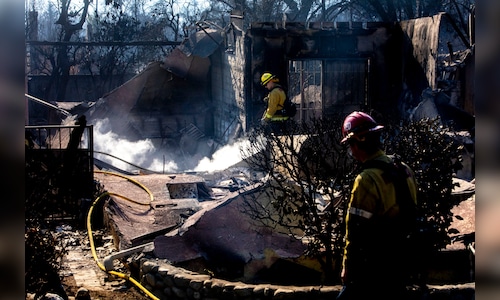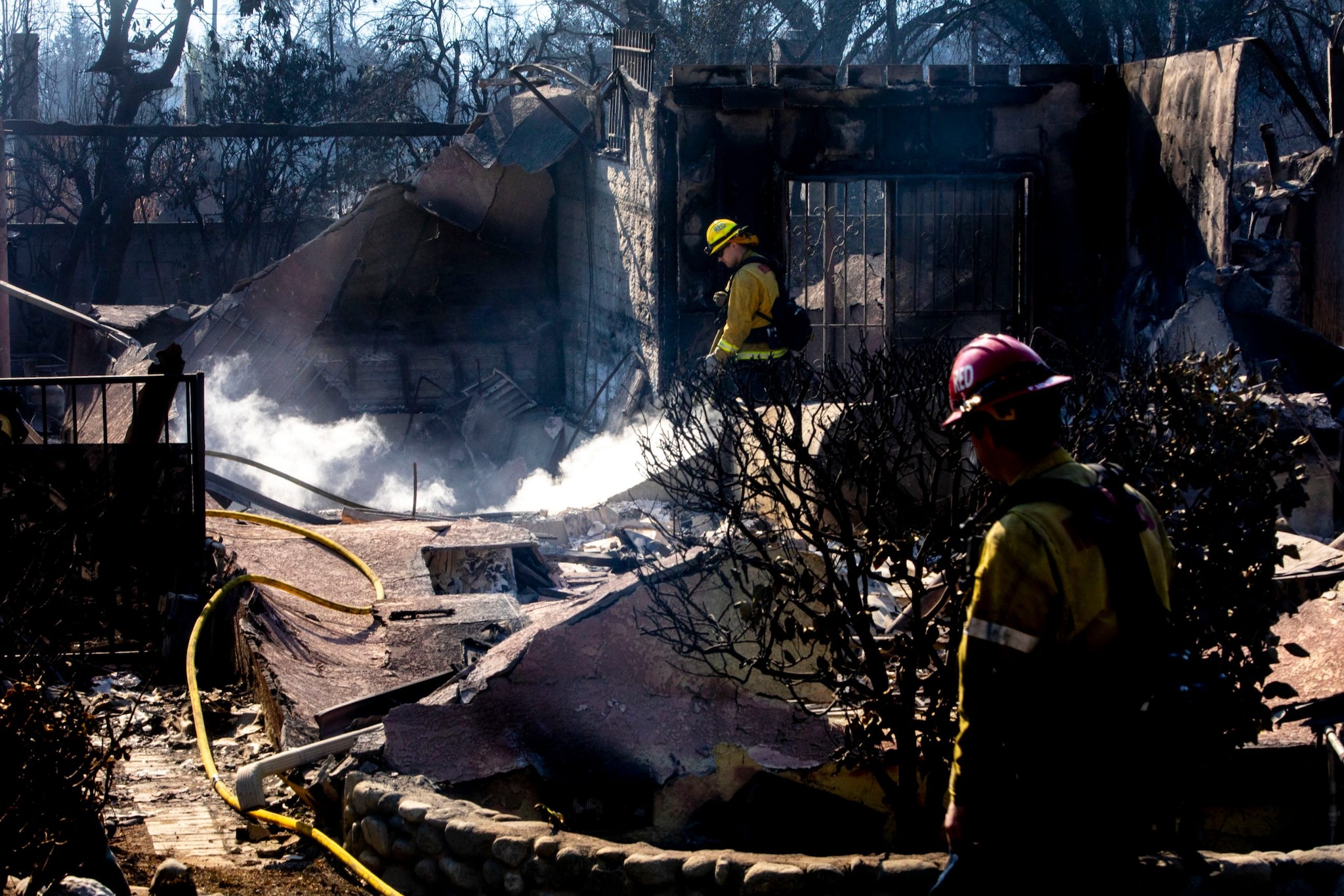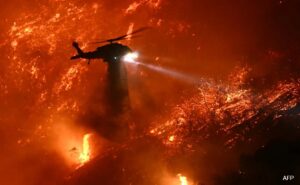

The spreading flames brought “another night of unimaginable terror and heartbreak,” Los Angeles County Supervisor Lindsey Horvath said early Saturday.
The expanded evacuation area covers some of Los Angeles’ most important cultural institutions, including the Getty Center, an architectural landmark with a world-class art collection. The historic cultural center has a fire-resistant design that may be put to the test.
Katherine Fleming, president and CEO of the J. Paul Getty Trust, said the art galleries are “safe and protected” and are being closely monitored.
The campus of the University of California at Los Angeles is on “high alert” and has been advised to prepare for evacuation, according to the California Department of Forestry and Fire Protection, known as Cal Fire. New areas of Bel Air east of the 405 freeway are now also on evacuation warning, Councilwoman Katy Yaroslavsky wrote in an email to her constituents.
The 2019 Getty Fire in the same area forced celebrities like LA Lakers star LeBron James and former California Governor Arnold Schwarzenegger to flee their homes. This weekend’s evacuation orders also include Encino.
“We are hurting, we are grieving, we are angry. And I am too,” Los Angeles Mayor Karen Bass told reporters Saturday.
After a brief break from the winds that gave firefighters a chance to make even small progress, dry winds will fan the blazes and likely persist through the first half of the coming week, leaving millions in peril, according to the US Storm Prediction Center.
The devastation has killed 16 people as of Saturday night. Eleven people died in the city of Altadena, from the Eaton Fire, while five died in the Palisades fire. Three of the 11 remains in the Eaton fire are still being processed by the Medical Examiner.
Thirteen people are missing, officials said. Another 19 people have been arrested in the Eaton Fire and additional three in the Palisades for curfew violations, burglary and looting. More than 16,000 people have applied for assistance from the Federal Emergency Management Agency, Regional Administrator Bob Fenton said.
No rain is in the forecast, weather officials said. Winds and dry conditions “will keep fire threat in LA County high,” county Fire Chief Anthony Marrone said Saturday.
Read more: Los Angeles Gains Ground on Fires as Finger-Pointing Begins
For almost a week, terror has spread across Los Angeles and its surrounding communities as thousands of homes and other buildings have been destroyed, and more than 180,000 have had to flee the spreading flames. The Palisades and Eaton fires have been so ferocious that they have already become the third- and fourth-most destructive in state history, and neither is out yet, according to Cal Fire.
States including Oregon, Washington, Nevada, Arizona, Texas and Montana have contributed resources to fight the California wildfires, Cal Fire Director and Fire Chief Joe Tyler said Saturday.
California Governor Gavin Newsom also announced Saturday that he has doubled National Guard personnel working on the fires to 1,680 responders. Altogether, the state has deployed more than 14,000 personnel to support firefighting efforts.
“The state has been working around the clock,” said Nancy Ward, director of the Governor’s Office of Emergency Services, on Saturday. Because of the severe weather anticipated Monday through Wednesday, the state has “surged” even more resources to fight the fire, bringing “the whole of the government to bear,” Ward said.
California officials have invited President-elect Donald Trump to tour the areas damaged by the fires, but he has not responded to them publicly. His staff didn’t immediately respond to a request for comment. Trump has put Newsom in particular under scathing criticism with refuted claims about the water situation in the state, going so far as calling for Newsom to resign.
Trump was known in his first term as well for politicizing disaster aid at least in terms of his commentary. In 2018, however, he issued a major disaster declaration for the Woolsey Fire, which devastated Malibu, speeding federal assistance to the area.
The fires also have put pressure on utilities that preemptively cut electricity to residents. Edison International’s Southern California power company has been asked by attorneys representing insurance companies to preserve evidence in connection with the Eaton Fire.
Edison has also said fire agencies are investigating whether the company’s equipment was involved in the ignition of the smaller Hurst Fire near San Fernando. “Right now, we don’t have any evidence that says that the Hurst Fire was caused by our equipment, but there’s a lot more investigation to be done,” President and CEO of Southern California Edison Steven Powell told reporters Saturday. As of Saturday morning, Edison has about 50,000 customers without power, he said.
The US Bureau of Alcohol, Tobacco and Firearms is taking over as the lead agency in the investigation into what started the fires, Los Angeles Police Chief Jim McDonnell announced Saturday.
“They have tremendous resources and expertise and can bring in resources from across the country to do their investigation,” McDonnell said.
California has a history of devastating wildfires sparked by electric utility equipment during wind storms. The state’s largest utility, PG&E Corp., filed for bankruptcy in 2019 after a series of deadly blazes blamed on its wires.
The fires are the most devastating natural disaster to strike Los Angeles since the 1994 Northridge earthquake, which killed 57 people, and are likely to rank among the costliest natural disasters in modern US history. Commercial-forecaster AccuWeather Inc. estimates direct and secondary losses, which account for uninsured destruction and indirect economic impact such as lost wages and supply-chain disruptions, may reach between $135 billion to $150 billion.
Early Saturday, the Palisades Fire had burned at least 22,660 acres (9,170 hectares) and was only 11% contained, while the Eaton blaze close to Pasadena had consumed 14,117 acres and was 15% contained, officials said. Newsom announced Saturday that the Hurst Fire was 76% contained. Among the fires, more than 10,000 structures have been destroyed. Crews are also battling three smaller incidents in the area.
While the crews are in the field, officials have begun to critique the region’s response.
Los Angeles City Fire Chief Kristin Crowley pointed the finger at city leaders for cutting her department’s budget, saying it hindered the firefight and told local television station Fox 11 “it did impact our ability to provide service.”
Bass, who trimmed more than $17 million in funding to the fire department, defended her actions on Friday, saying the reductions came during “tough budgetary times” and didn’t affect the wildfire response.
She addressed them again on Saturday, saying “any differences that we might have will be worked out in private, but right now, our first and most important obligation to Angelenos is to get through this crisis.”
Newsom sent the Los Angeles Department of Water and Power a letter requesting a review of why hydrants in the fire zones repeatedly ran low on water. He pointed to a reservoir that the Los Angeles Times reported had been closed for repairs when the fires struck, calling the lack of water “deeply troubling to me and to the community.”
Gusts will likely reach 40 miles (64 kilometers) to 60 miles per hour by early next week, said Ryan Kittell, a National Weather Service meteorologist in Oxnard, California.
“It’s a step down from what we had earlier this week, but it is still quite significant,” he said.



